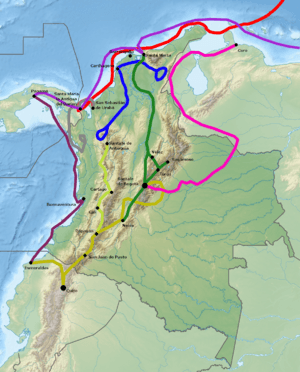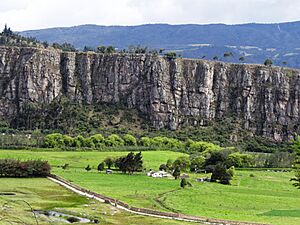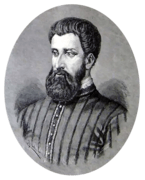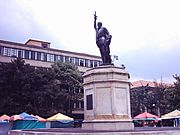Gonzalo Jiménez de Quesada facts for kids
Quick facts for kids
Gonzalo Jiménez de Quesada
|
|
|---|---|
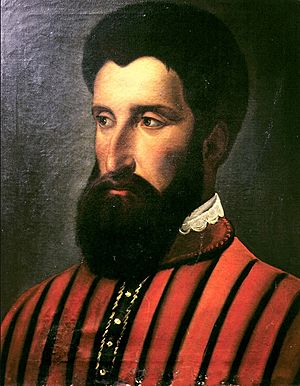
Oil portrait of Gonzalo Jiménez de Quesada (unknown artist, Museo Nacional de Colombia, Bogotá)
|
|
| Born | 1496 (or 1506 or 1509) |
| Died | 16 February 1579 (aged ~70–85) |
| Nationality | Castilian |
| Other names | Gonzalo Jiménez de Quezada Gonzalo Ximénez de Quesada |
| Occupation | Conquistador, Explorer |
| Years active | 1536–1572 |
| Employer | Spanish Crown |
| Known for | Spanish conquest of the Muisca Spanish conquest of the Chibchan Nations Founder of Bogotá First mayor of Bogotá Quest for El Dorado |
|
Notable work
|
Memoria de los descubridores, que entraron conmigo a descubrir y conquistar el Reino de Granada (1576) |
| Parents |
|
| Relatives | Hernán Pérez de Quesada (brother) Francisco Jiménez de Quesada (brother) Melchor de Quesada (brother) Catalina Magdalena de Quesada (sister) Andrea Ximénez de Quesada (sister) Isabel de Quesada (half-sister) |
| Mayor of Bogotá | |
| In office 1538–1539 |
|
| Preceded by | position established; zipa Sagipa) |
| Succeeded by | Jerónimo de Lainza |
Gonzalo Jiménez de Quesada (born around 1496, died February 16, 1579) was an important Spanish explorer and conquistador. A conquistador was a Spanish soldier and explorer who helped conquer new lands for Spain. Gonzalo explored the northern part of South America, which is now Colombia.
He was a well-educated lawyer and a smart leader. He helped create the first laws for the area he explored. He also wrote down the history of his journeys. Later in his life, he searched for the legendary golden city of El Dorado. Some people even think he might have inspired the famous book character, Don Quixote.
Contents
Family and Early Life
Gonzalo's father was Luis Jiménez de Quesada. Gonzalo had three younger brothers: Hernán, Francisco, and Melchor. Hernán and Francisco also became conquistadors. He also had two sisters, Andrea and Catalina.
Exploring New Lands: The Muisca Conquest
Gonzalo Jiménez de Quesada was a lawyer from Spain. In 1535, he was chosen to be a chief judge and second-in-command for a trip to what is now Colombia. The leader of the trip, Pedro Fernández de Lugo, hoped to find a very rich land.
They sailed to Santa Marta, a small coastal town. But it was not what they expected. The town was poor, and many people got sick. Food was hard to find.
The Journey Inland
In 1536, De Lugo picked De Quesada to lead an expedition into the heart of New Granada. They hoped to find the famous El Dorado. De Quesada, who had no military experience, led his men south from Santa Marta. They faced many challenges on their journey.
They traveled up the Magdalena River. The journey was very difficult. Many men died from hunger and disease. They had to eat snakes, lizards, frogs, and even parts of their leather gear to survive. Out of 800 men, only 179 survived the harsh jungle.
Meeting the Muisca People
After a long and hard journey, they reached the lands of the Muisca Confederation. The Muisca were a group of native people with two main rulers. One ruler, Tisquesusa, was in charge of Muyquytá. The other, Quemuenchatocha, ruled in Hunza.
De Quesada's group took advantage of a war between these two Muisca leaders. They first took control of Muyquytá. Then, they successfully attacked Hunza.
Founding Bogotá
It was time to build a new settlement. De Quesada and his men chose a high spot near tall mountains. This place would protect them from attacks and heavy rains.
De Quesada officially claimed the land for Spain. He named the new settlement Santa Fé de Bogotá. This name came from the Muisca word "Bacatá." Today, it is simply known as Bogotá, the capital of Colombia.
Sharing the Land
De Quesada stayed in the area until late 1538. Then, two other explorers arrived: Sebastián de Belalcázar from Ecuador and Nikolaus Federmann, a German from Venezuela. All three wanted to claim New Granada for themselves.
To solve this problem, De Quesada convinced them to go back to Spain. They would let the Spanish King decide who would govern the new lands. They sailed to Spain in 1539. However, none of them became the governor.
De Quesada returned to New Granada in 1550. He lived there for almost twenty years. He was a respected colonist and a very important person in the colony. He tried to protect other colonists and control the greed of large landowners. But he still dreamed of finding more wealth and gold.
Later Expeditions and Final Years
In 1569, when he was 63 years old, De Quesada led another big expedition. He wanted to explore the eastern plains, called the Llanos. He left Bogotá with many soldiers, native people, horses, and animals.
This expedition was also very difficult. Much of their livestock was lost in a fire. After two years of searching, De Quesada reached the Orinoco River. He realized he could not go further without building ships.
He sadly returned to Bogotá in 1572. Only a few of his men and animals survived. This trip was one of the most expensive disasters in history. After this, De Quesada became ill with leprosy. He was also in a lot of debt. He moved to a milder climate and died quietly in Mariquita. He was between 70 and 85 years old.
Death and Legacy
Gonzalo Jiménez de Quesada was first buried in Mariquita. Later, in 1597, his remains were moved to Bogotá. This was the city he had founded.
Places Named After Jiménez de Quesada
- Avenida Jiménez, an important street in central Bogotá.
- Avenida Jiménez (TransMilenio), a bus station on this street.
- Torres Gonzalo Jiménez de Quesada, a group of residential towers in Bogotá.
Gallery
Images for kids
See also
 In Spanish: Gonzalo Jiménez de Quesada para niños
In Spanish: Gonzalo Jiménez de Quesada para niños


